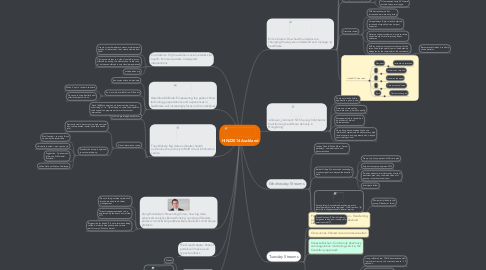
1. HL7NZ FHIR Workshop
1.1. Wicked
1.2. Josh Mandel: SMART on FHIR (Securing the ecosystem)
1.2.1. bit.ly/sof-nz
2. The Great Debate: Patient portals will make us all hypochondriacs
3. Craig Richardson: Preventing Crime; how big data, advanced analytics & new thinking can stop offenders, protect victims & help address New Zealand's child abuse problem
3.1. No such thing as threat prevention; instead we need to do threat management
3.2. Threat management needs to be addressed by the board not just the CIO
3.3. Biggest risk for health IT is not information being stolen, but slowly being changed over time - which is very difficult to detect
4. Tony Blakely: Big data and better health outcomes, the journey to MoH virtual information centre.
4.1. NHI is a great opportunity for us
4.2. 'Virtual information centre'
4.2.1. Previously would have stood up here and said 'don't setup another center [to collate health info]'
4.2.2. Possibly the timing is right now to set something up
4.2.2.1. MoH funded = too risky & not owned by the researchers
4.2.2.2. University funded = won't get buy in
4.2.2.3. Suggestion: Co-governed, follow the SHIP model (Scotland)
4.2.2.4. Utilise National Science Challenge
5. Geraldine McBride: Empowering the patient: How technology, expectations and experiences in healthcare will increasingly focus on the individual
5.1. Anonymous data is dead data
5.2. So much info available from Fitbits etc
5.2.1. Make it 'opt-in' to share this data
5.2.2. Prove you're living healthily and offer incentives to do so
5.3. 'Frank' (MyWave app) can do intent casting (among other things) - i.e. 'I think I need to come to hospital' so the hospital can prepare earlier or offer another intervention
6. Ciro Cattuto: High resolution social networks for health: from sensor data to targeted interventions
6.1. Uses low cost hardware to create social network graphs of interactions, then create models from them
6.2. Closing two classes in a school could be just as effective as closing the whole school in the case of a disease outbreak in one class (paraphrased!)
6.3. sociopatterns.org
7. NT Cheung: Informatics transforming healthcare delivery in Hong Kong
7.1. Check out Health Affairs, apparently a good journal
7.2. Data use = data quality Low data use = poor data quality
7.3. Management data should be a by-product of clinical documentation
7.4. Hong Kong have developed in house information systems which deliver a very high level of uptime, and apparently don't require user training to use!
8. Enrico Coiera: How health analytics are changing the way we understand and manage healthcare
8.1. Temporal patterns
8.2. 40-60%(?) of lab results in US never followed up according to literature (source?)
8.3. Conducted a similar study at a training hospital in Sydney
8.3.1. 40% of inpatients had one or more results not viewed
8.3.2. Of unreviewed tests, 20% were outside the normal range
8.4. Literature review
8.4.1. EHR decrease nurse but increase doctor data entry times
8.4.2. Care pathways & plans reduce practice variation but typically do not impact outcomes
8.4.3. Decision support systems do improve safety and efficiency of care/improve patient outcomes
8.4.4. EHR by itself is most useful at the start of the value chain (although this point is debated by delegates for the remainder of the conference!)
8.4.4.1. Becomes useful when it can help us see patterns
8.5. Health IT Value chain
8.5.1. Frequent
8.5.1.1. Increases interaction
8.5.2. -
8.5.2.1. Information received
8.5.3. -
8.5.3.1. Decision changed
8.5.4. -
8.5.4.1. Care process altered
8.5.5. Rare
8.5.5.1. Outcome changed
9. Tuesday Streams
9.1. Peter Jordan: GP2GP in Action - Transferring patient records around New Zealand electronically
9.2. Olivia Jones: Shared care record evaluation
9.3. Vanessa Buchan: Community pharmacy anticoagulation monitoring service, the Canterbury approach
9.4. Peter Brook & David MacKay: VDI - a foundation for digital health
9.4.1. Using vmWare View, CDHB have reduced staff login times from up to 5 minutes down to ~10 seconds
9.4.2. Security increased by using zero clients and no generic logons
9.4.3. SSO to the whole platform (forgotten the name of the product they were using)
9.4.4. Embedded IT support in critical areas during the transition to help users trust the new system
10. Wednesday Streams
10.1. Janfrey Doak & Phyllis Meier: Cancer pathways - communication and documentation
10.2. Rachel Vickery: Patient-centric technology moves surgical care beyond the hospital walls
10.2.1. Pre-op to post-op patient info & care plan
10.2.2. Surgical concepts paper due 2015
10.2.3. Provides patient more interactivity over their treatment plan, they can watch videos for post-op instruction/exercise etc
10.2.4. Investigate further
10.3. Koray Atalag: A standards-based approach to development of clinical registries - initial lessons learnt from the gestational diabetes registry
10.3.1. (Temporarily linked to the wrong Slideshare I think)
